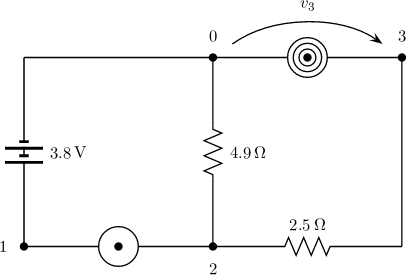This page provides a few examples and templates for various analyses that are available from the autoCircuits SPICE interface. For each example, a problem statement is provided together with the associated circuit diagram and the corresponding SPICE netlist. The latter can be directly copied-and-pasted into the input netlist field. For a detailed description of syntax rules and available components and analyses, click here.
Find the voltage across resistor R_3.
V_1 1 0 dc R_2 1 2 R_3 2 0 R_4 2 3 R_5 3 0 .DC SOLVE V(3,0)
Note: all element values are randomized.

Find the current through resistors R_2 and R_7.
V_1 1 0 DC R_2 1 2 E_3 2 4 1 2 G_4 1 2 2 4 R_5 2 3 R_6 3 4 R_7 4 0 .DC SOLVE I(R_2) I(R_7)
Note: all element values are randomized.
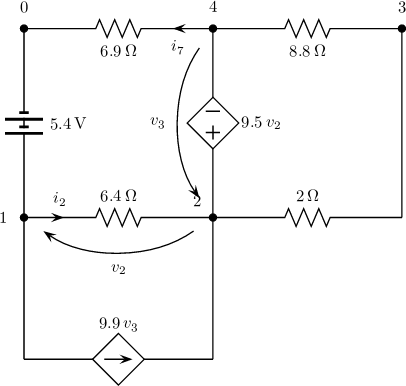
Find the Thevenin equivalent at port P_AB.
P_AB 1 0 R_1 1 2 F_2 2 0 R_3 R_3 2 3 V_4 3 0 DC .DC THEVENIN P_AB
Note: all element values are randomized.

Find the AC equivalent impedance at port P_1.
P_1 1 0 C_1 1 0 R_2 1 2 L_3 2 0 .AC ZEQ P_1
Note: element values and frequency are randomized.

Find the voltage across inductor L_4.
I_1 1 0 AC R_2 1 0 C_3 1 2 L_4 2 0 .AC SOLVE V(2,0)
Note: all element values are randomized.
Note: source magnitude, frequency and phase are randomized.
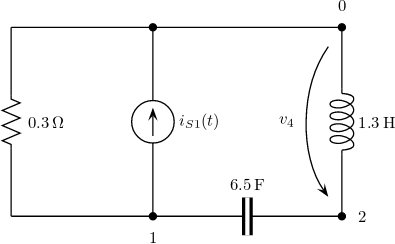
Find the AC power supplied by the voltage source.
V_1 1 0 AC R_2 1 2 C_3 2 0 L_4 2 3 H_5 3 0 R_2 .AC POWER V_1
Note: all element values are randomized.
Note: source magnitude, frequency and phase are randomized.
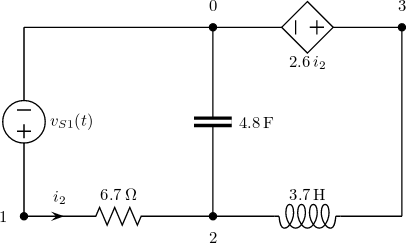
Find the steady-state current through L_1.
L_1 1 0 V_2 1 2 DC I_3 2 0 AC R_4 2 3 V_3 3 0 AC .AC MULTIFREQ I(L_1)
Note: all element values are randomized.
Note: DC sources value is randomized.
Note: AC sources magnitude, frequency and phase are randomized.
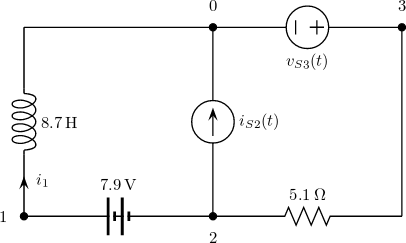
Find the poles of the circuit.
L_1 1 3 V_2 1 2 DC R_3 2 0 G_4 2 0 1 3 C_5 3 0 .LTI POLES
Note: all element values are randomized.

Find the transfer function between V_1 and I(L_4).
V_1 1 2 TF R_2 2 3 C_3 1 0 L_4 3 0 R_5 3 0 .TF V_1 I(L_4)
Note: all element values are randomized.
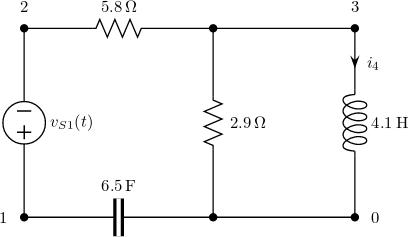
Find the expression of voltage V(2,0).
V_1 1 0 DC R_2 1 2 S_3 2 3 S2O R_4 3 0 C_5 2 0 .TRAN SOLVE V(2,0)
Note: element values and sources are randomized.

Find the expression of voltage V(2,0)
.V_1 1 0 DC_ON R_2 1 2 V_3 2 3 DC_OFF C_4 3 0 L_5 3 4 R_6 4 0 S_7 4 0 O2S .TRAN SOLVE V(3,0)
Note: element values and sources are randomized.
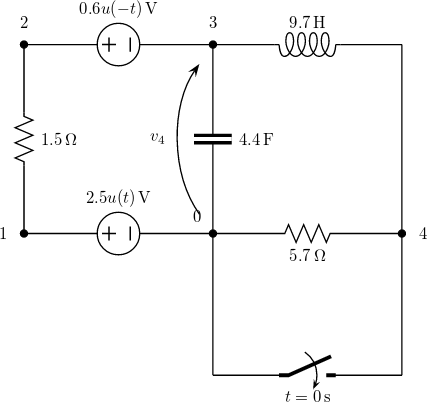
Formulate the Modified Nodal Analysis.
V_1 1 0 DC L_2 1 2 C_3 2 0 R_4 2 0 R_5 1 2 .LTI MNA
Note: element values and sources are randomized.

Find the impedance matrix.
P_1 1 0 P_2 2 0 L_3 1 2 C_4 2 0 .LTI ZMATRIX P_1 P_2
Note: all element values are randomized.
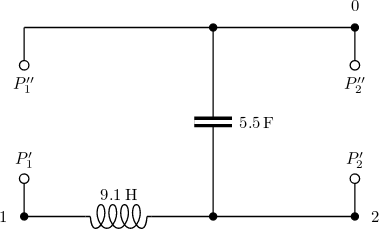
Find the AC Norton equivalent at terminals (A,B).
L_1 1 0 L_2 2 0 K_12 L_1 L_2 R_3 1 2 I_4 1 2 AC P_AB 1 0 .AC NORTON P_AB
Note: all element values are randomized.
Note: coupling coefficient is randomized.
Note: source magnitude, frequency and phase are randomized.

Find the voltage V(3,0).
V_1 1 0 DC O_2 1 2 3 R_3 2 0 R_4 2 3 .DC SOLVE V(3,0)
Note: all element values are randomized.
Note: OpAmps are represented as nullator-norator pairs.
